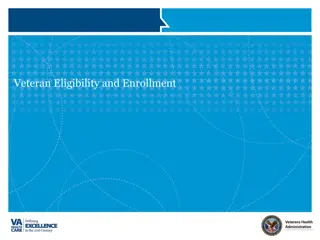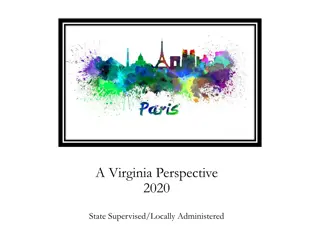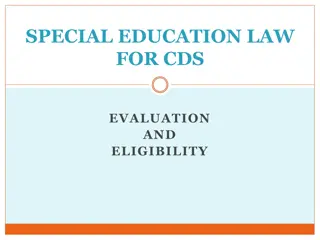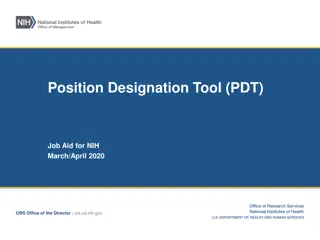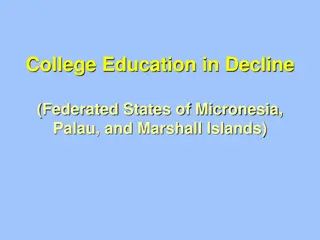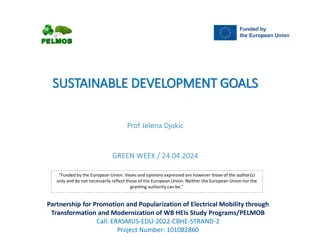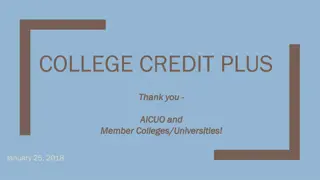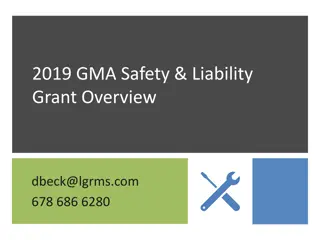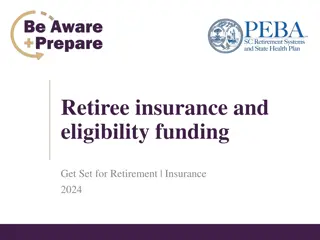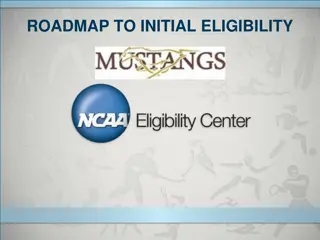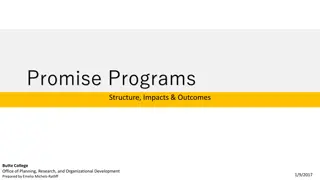Understanding Designation of Eligibility for Higher Education Programs
This informative content delves into the process of identifying institutions of higher education as eligible for funding under Titles III and V of the Higher Education Act of 1965. It covers eligibility criteria, application procedures, and the impact of eligibility on various federal programs. The presentation aims to clarify concepts and procedures related to eligibility designation in the educational context.
Download Presentation

Please find below an Image/Link to download the presentation.
The content on the website is provided AS IS for your information and personal use only. It may not be sold, licensed, or shared on other websites without obtaining consent from the author. Download presentation by click this link. If you encounter any issues during the download, it is possible that the publisher has removed the file from their server.
E N D
Presentation Transcript
Designation as an Eligible Institution for Titles III & V Programs Office of Postsecondary Education 1
Jason Cottrell, Ph.D. Jason.Cottrell@ed.gov Research Analyst Institutional Program Development Division Christopher Smith Christopher.Smith@ed.gov Management and Program Analyst Strengthening Institutions Division 2
Webinar Objectives What is Eligibility? Who can apply for eligibility? How are eligibility decisions made? What is the Eligibility Matrix? How does eligibility affect non-federal cost- share? How do I determine if I am eligible? How do I submit an application and/or waiver? What happens next? Questions? 3
What is Eligibility? This process identifies an institution of higher education (IHE) as: Eligible to apply for funding under Titles III and V of the Higher Education Act of 1965, as amended by the Higher Education Opportunity Act of 2008 (HEA). Eligible for certain non-Federal cost-share waivers. Eligibility does not designate nor certify any institution as a particular type of institution such as an HSI. 4
Who can apply for Designation of Eligibility? An IHE that: Is accredited or pre-accredited by a nationally- recognized accrediting agency or association and Provided required data into the Integrated Postsecondary Education Data System (IPEDS) database for the academic year immediately preceding the most recent complete academic year. 5
Who should apply for Designation of Eligibility? All Institutions of Higher Education (IHE) who meet the previous requirements. Applicants planning to apply for a grant under the SIP, HSI, PPOHA, ANNH, NASNTI, AANAPISI or PBI Programs. An institution must be deemed as an eligible IHE to be considered for funding under these programs. You MUST apply for eligibility even if you have a current Titles III, V, or VII grant. Applicants requesting a waiver of the non-Federal cost share requirements under any of the following programs: The Federal Work-Study program (FWS); Federal Supplemental Educational Opportunity Grants program(FSEOG); TRIO Student Support Services program (SSS); and Undergraduate International Students and Foreign Language program (UISFL). 6
What is a branch campus? An accredited branch campus that: Is geographically apart from, and independent of, the main campus; Is permanent in nature; Offers courses for credit and programs leading to an associates or bachelors degree; Has its own faculty and administrative or supervisory organization; and Has its own budgetary and hiring authority. 7
What two variables determine Eligibility? Needy Students: At least 50 percent of an institution s degree-seeking students received financial assistance under: the Federal Pell Grant, Federal SEOG, Federal Work Study, or the Federal Perkins Loan Programs. Or, the percentage of an institution s undergraduate degree-seeking students who were enrolled at least half-time and received Federal Pell Grants exceeds the average percentage of the same at similar (type and control) institutions. Core Expenses per FTE: Core Expenses are regular operational expenditures of postsecondary institutions (excluding auxiliary enterprises, independent operations, and hospital expenses). These are then divided by the FTE (12-month undergraduate enrollment for the academic year). This measure is then compared to the average value for other similar (type and control) institutions. The Core Expenses per FTE measure must be lower than the average for the institutional group. 9
What about Titles III and V program requirements? Grant Specific Requirements ANNAPISI Asian and Pacific Islander UG enrollment equal to or greater than 10% ANNH - Native American UG enrollment less than 20% and Pacific Islander UG enrollment equal to or greater than 10% NASNTI - Native American UG enrollment equal to or greater than 10% HSI, HSI Stem and PPOHA Hispanic FT UG enrollment equal to or greater than 25 % MSEIP Total minority enrollment except Asian equal to or greater than 50% PBI and PBI-MA Black enrollment equal to or greater than 40% 10
Eligibility Matrix (EM) The computation of eligibility is conducted annually at the time that IPEDS data is provisionally released for the academic year immediately preceding the most recent complete academic year. Provisional release data occur generally in the fall of the year so it is anticipated that the EM computation and release will occur around January/February of each year. These data generate a provisional EM. 11
Sample portion of the Eligibility Matrix: data from FY 2013-2014 Unit ID 444398 03733300 Baptist University of the Americas 155070 00191700 Barclay College 189088 00267100 Bard College 167792 00964500 Bard College at Simon's Rock 189097 00270800 Barnard College Barnes-Jewish College Goldfarb School of Nursing 132471 00146600 Barry University 109907 00111900 Barstow Community College 197911 00290800 Barton College 154697 00460800 Barton County Community College 235547 02242500 Bastyr University 160977 00203600 Bates College 235671 00530600 Bates Technical College 437103 03730300 Baton Rouge Community College 168883 00224000 Bay de Noc Community College 380359 03066600 Bay Mills Community College 164632 00212200 Bay Path College 241225 00502200 Bayamon Central University 223223 00494900 Baylor College of Medicine 223232 00354500 Baylor University 384254 03373300 Beacon College 197966 00855800 Beaufort County Community College 164720 00212300 Becker College 476717 04192800 Be'er Yaakov Talmudic Seminary 444413 03713300 Beis Medrash Heichal Dovid 190956 00644800 Belanger School of Nursing 175421 00239700 Belhaven University 156286 00195400 Bellarmine University 234669 00376900 Bellevue College 180814 00974300 Bellevue University 238324 00663900 Bellin College 234696 00499900 Bellingham Technical College 197984 00291000 Belmont Abbey College OPE ID Institution Name AANAPISI Elig ANNH Elig HBCU Elig HBCU Masters Elig HBGI Elig 1 1 2 1 1 2 1 1 2 1 1 2 4 1 2 HSI Elig 5 1 1 1 1 HSI Stem Elig MSEIP Elig NASNTI Elig PBI Elig PBI Masters Elig PPOHA Elig 5 5 1 1 1 1 1 1 1 1 1 1 1 1 1 SIP Elig 5 5 4 4 4 TCCU Elig 2 2 2 2 2 2 2 2 2 2 2 2 2 2 2 1 1 1 1 1 1 1 1 1 1 2 1 1 1 1 177719 00638900 1 1 1 1 3 5 1 1 3 3 3 3 3 2 1 1 1 3 1 2 1 1 1 4 1 1 3 1 1 1 1 1 3 1 1 1 3 3 3 3 3 2 1 1 1 3 1 2 1 1 1 1 1 1 3 1 2 2 2 2 2 2 2 2 2 2 2 2 2 2 2 2 2 2 2 2 2 2 2 2 2 2 2 2 2 2 2 2 2 2 2 2 2 2 2 2 2 2 2 2 2 2 2 2 2 2 2 2 2 2 2 2 2 2 2 2 2 2 2 2 2 2 2 2 2 2 2 2 2 2 2 2 2 2 2 2 2 2 2 2 1 5 5 1 3 1 1 1 3 3 3 3 6 2 1 1 1 3 1 2 1 1 1 1 1 1 3 1 1 5 5 1 1 1 1 1 1 1 1 1 6 2 1 1 1 1 1 2 1 1 1 1 1 1 1 1 1 5 5 1 1 1 1 1 1 1 4 1 5 2 1 1 1 1 1 2 1 5 1 1 1 1 1 1 1 1 1 1 3 1 1 1 3 3 3 3 3 2 1 1 1 3 1 2 1 1 1 1 1 1 3 1 1 1 1 1 3 1 1 1 3 3 3 3 3 2 1 1 1 3 1 2 1 5 1 1 1 1 3 1 1 1 1 1 1 1 1 1 1 1 1 1 3 2 1 1 1 1 1 2 1 5 1 1 1 1 1 1 1 5 2 1 1 1 1 1 1 1 3 1 6 2 1 1 1 1 1 2 1 1 1 1 1 1 1 1 4 5 5 5 6 5 4 5 6 6 3 6 3 2 4 4 4 6 5 2 2 2 2 2 2 2 2 2 2 6 2 2 2 2 2 2 2 2 2 2 2 2 2 2 2 2 2 4R 4 5 4 4 4 4 6 5 12
Eligibility Matrix (EM) The criteria derived from applicable legislation and regulations were applied to enrollment and financial data from IPEDS and FSA files to determine eligibility for each institutional program. The process resulted in the following six categories: Code 1: Institution is ineligible doesn t meet minority student enrollment requirements for the program. 13
Eligibility Matrix (EM) Code 2: Institution is ineligible there are no program participants in a key category (e.g. graduate students for HBCU-MD, PPOHA, PBI- MA), the institution has no Pell grant recipients or needy students, has only religious vocational programs, or is not a legislatively-designated institution (i.e. not an HBCU or TCCU). 14
Eligibility Matrix (EM) Code 3: Institution is ineligible they have a current grant for another IS program, and therefore by law may not simultaneously have two Part A grants. Code 4: Institution is potentially eligible on minority grounds but would need to apply for a waiver of Pell or needy student criteria. Code 5: Institution is potentially eligible to apply for a grant for this program. Code 6: Institution is a current grantee of this program. 15
Eligibility Matrix (EM) There are a number of institutions that are not eligible to receive grants from the Office of Postsecondary Education - Institutional Service. For-profit institutions are not included in the EM structure. Institutions with only religious-vocational programs, on the other hand, are included in the EM structure, since they may (and, with some frequency, do) establish non-vocational program offerings. The Department will periodically review institutions noted as religious-vocational in the EM structure, and will provide a means by which institutions may notify the Department of their change in status. 16
Update to Non-Federal Cost-Share Waivers An IHE that submits an application, and is designated as an eligible institution, will receive a waiver of certain non-Federal cost-share requirements for one year or for the duration of their Titles III or V grant, if awarded, under the Federal Supplemental Educational Opportunity Grants (FSEOG) and the Federal Work Study program (FWS). Qualified institutions will receive FWS and FSEOG waivers for one year even if they do not receive a grant under the Titles III or V Programs. 17
Update to Non-Federal Cost-Share Waivers Cost-Share waivers for the Federal Work-Study program and the Federal Supplemental Education Opportunity Grants are administered through Federal Student Aid. Questions pertaining to these Cost-Share waivers must be directed to the Campus- Based Call Center: 1-877-801-7168 CBFOB@ED.Gov 18
Non-Federal Cost-Share Waivers If the institution receives a grant from the UISFL or SSS program, you may receive a waiver or reduction of the required non-Federal share for institutions for the duration of the grant. Questions pertaining to the UISFL cost-share waiver must be directed to: Ms. Tanyelle Richardson Email: Tanyelle.Richardson@Ed.Gov Questions pertaining to the SSS cost-share waiver must be directed to: Ms. Reshone Moore Email: Reshone.Moore@Ed.Gov 19
Check Eligibility Visit HTTPS://HEPIS.ed.gov/Title3and5 , Click on Application for Designation as an Eligible Institution, Check your eligibility by clicking on Check Main Campus Eligibility and following the directions. If you are eligible, you can download your 2018 letter of eligibility. If you aren t eligible, you will return to the application screen and follow the prompts to login and submit an application and/or waiver. 20
Eligible Eligible applicants will immediately receive their Eligibility letter. Eligible branch campuses will have access to their letter after April 2, 2018. Ineligible applicants will have access to their letter after April 2, 2018. Eligibility staff must confirm the branch campus meets the definition of an accredited branch campus. 21
Submitting the Application Applications for eligibility should be completed and submitted electronically at: HTTPS://HEPIS.ed.gov/Title3and5 Note: The notice inviting applications (NIA), as published in the Federal Register on February 14, 2018 contains instructions for applicants unable to submit their application electronically. 22
Before you get started Read the entire application package available by visiting HTTPS://HEPIS.ed.gov/title3and5 and clicking on the eligibility link. Have the following information: Institution/campus OPE ID number Total institutional enrollment for fall 2015 Minority enrollment for fall 2015 Number of Pell recipients for fall 2015 Number of students enrolled at least half-time in a degree program for fall 2015 Total Core Expenses for 2015-2016 23
Total Institutional Enrollment Institution s 2015 fall semester head count of enrolled undergraduate and graduate students. Do not include international students who are ineligible to participate in Title IV need-based financial assistance programs. Do not include high school students who are enrolled in dual enrollment and who are ineligible to participate in Title IV need-based financial assistance programs. 24
Need-Based Financial Assistance Title IV need-based financial assistance: Determine the institution s total 2015 fall semester, unduplicated, student head count of degree-seeking students who received any of the following Title IV need-based assistance: Federal Pell Grant; Federal Work Study; Federal Perkins Loan; or Federal Supplemental Educational Opportunity Grant. 25
Need-Based Financial Assistance To compute the unduplicated student head count, count, only once, each student who received Title IV need-based assistance, regardless of the number of need-based programs in which the student participated. 26
Half-Time Enrollment Enrollment of half-time, up to and including, full-time undergraduate students: Determine the institution s total 2015 fall semester undergraduate head count of students who were enrolled at least half time in degree programs at your institution. Do not include international students who are not eligible for Title IV need-based financial assistance. Do not include high school students enrolled in dual enrollment who are not eligible for Title IV need-based financial assistance. 27
Core Expenses Since 2004, the National Center for Education Statistics (NCES) has calculated Core Expenses per FTE for Postsecondary Institutions.* The Department determined that the Core Expenses measure is statistically similar to the former E&G per FTE. *Note: Please review the definition for Core Expenses that s located in the application booklet. 28
Core Expenses Core Expenses per FTE uses 12-month enrollment figures. Institutions applying for Eligibility must use the Core Expenses reported to the Integrated Postsecondary Education Data System (IPEDS) for academic year 2015-2016. 29
Core Expenses Determine the Institution s Core Expenses for 2015-2016. Do not include federal student financial aid. If it is included, you may deduct it from your Core Expenses Average Core Expenses per FTE student. The system will do this calculation for you. 30
2015-2016 Average Pell Grant and Core Expenses per FTE Student Type of Institution 2015-2016 Average Pell Grant Percentage 2015-2016 Core Expenses per FTE Student 38 $13,154 Two-year, Public Two-year, Non-profit, Private 59 $14,349 38 $30,044 Four-year, Public 39 $38,307 Four-Year, Non-profit, Private 31
Needy Student Requirement Your institution meets the needy student requirement if: At least 50% of your 2015 fall, unduplicated student head count of undergraduate and graduate students received financial assistance under one or more of the following programs: Federal Pell Grant; Federal Work-Study; Federal Perkins Loan, or Federal Supplemental Educational Opportunity Grant programs (Part III, 1.B) OR 32
Needy Student Requirement The percentage of your 2015 fall semester, undergraduate, degree-seeking students who were enrolled on at least a half-time basis, and received Federal Pell Grants, exceeded the average percentage of undergraduate degree students who were enrolled on at least a half- time basis, and received Federal Pell Grants, at comparable institutions that offered similar instruction. (Part III, 1.D) 33
Ineligible If deemed ineligible based on system calculations, institutions may choose to submit a waiver. 34
Waivers Institutions that are unable to meet the needy student enrollment requirement, or the average Core Expenses requirement, may apply for a waiver*, The applicant MUST address the waiver in its entirety and include all the required documentation, evidence, and data pertaining to the waiver as instructed in the application. * See application booklet for waiver instructions and required information. 35
Waiver Options There are six (6) waiver options for the needy student enrollment requirement. There are five (5) waiver options for the average Core Expenses per FTE requirement. An institution may choose to respond to one or more waiver options. Waiver options are detailed in the application booklet. 36
Helpful Hints Please upload supporting documents in the following formats: Microsoft Word, Excel, PDF, GIF, or JPEG. Supporting Documentation and Data, Data, Data All passwords are reset annually. The System opened on February 14, 2018 Username: Your OPEID Password: title3 You will reset your password when you login. 38
More Information The official FY 2018 Designation as an Eligible Institution Application Booklet and the Notice (NIA) for this program can be found online at: http://www.ed.gov/about/offices/list/ope/idue/ind es.html *Note: This presentation does NOT supersede reading and following the instructions in the application booklet and NIA 39
FY 2018 Application Deadline Deadline: March 16, 2018 11:59pm Contact Information Christopher M. Smith Christopher.Smith@Ed.Gov 202-453-7946 Jason Cottrell, Ph.D. Jason.Cottrell@Ed.Gov 202-453-7530 Important! Do not wait until the last day to submit your application. 40







